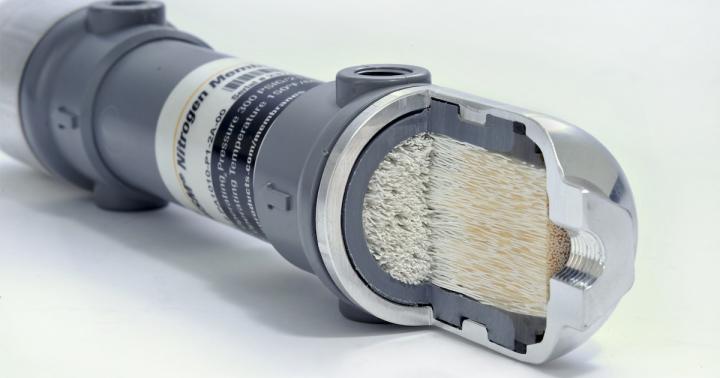
Credit: Hills Inc.
LAWRENCE — A $1 million, 18-month collaboration between the University of Kansas School of Engineering and the RAPID Manufacturing Institute for Process Intensification launched in 2017 by the American Institute of Chemical Engineers will develop technology to separate gas using renewable, high-performance furanic-based polymers that were originally developed for replacing PET-based soda bottles.
The research is supported by a new $384,927 grant from the Department of Energy (DOE) and includes collaborations with DuPont, Hills Inc. and Air Products.
The investigation at KU, dubbed “Project H22020,” could result in membranes that reduce capital costs by a factor of 10 and increase hydrogen recovery by 20% while reducing both waste and the cost of separation by 20%. Such a breakthrough would be a boon to companies that refine oil and produce hydrogen fuel cells, replacing gas-separation technology used today made from materials developed in the 1970s and 1980s.
“These are furanic-based polymer membranes — it’s a new material that the DuPont Company is commercializing,” said Mark Shiflett, Foundation Distinguished Professor at the KU School of Engineering, who is leading the work. “Think of it as a new plastic. The ultimate reason that they’re making it is as a replacement for PET, the plastic that’s used to produce most beverage bottles. So, when you buy a two-liter Coke or liter of water, the bottle is made out of PET (polyethylene terephthalate) that ultimately comes from petroleum. These furanic-based polymers will replace PET to manufacture what are basically green water and soda bottles. These furanic-based polymers don’t come from petroleum but natural starting materials like fructose.”
The KU researcher said furanic polymers are an ideal material to use for industrial gas separation because they’re largely impermeable to larger gas molecules.
“Take like a soda bottle — the beverages in them are carbonated, and all the water and the sugar and flavorings are under pressure, carbonated with carbon dioxide,” Shiflett said. “You want a plastic that carbon dioxide doesn’t permeate through. Otherwise, all your soda bottles would be flat when you open them. And you don’t want oxygen to go in, because that can cause problems with taste and oxidation. You bottle the soda and stick it on a shelf someplace in the warehouse and then ultimately it gets delivered to a store, and a customer picks it up and, later on, they drink it. Well, that can be a pretty long time period — it could be months to possibly years between the time it was manufactured and the time you actually drank it. So, those plastics have to be really good in terms of keeping the CO2 in and keeping the O2 out. These new furanic polymers that DuPont is commercializing are natural based, which everybody wants. And, and they’re excellent at keeping the CO2 from leaking out and the O2 from going in.”
However, Shiflett said furanic-based membranes are in a sweet spot because they could allow smaller gas molecules to pass through, making them suitable for industrial-scale gas separation.
“We’re interested in studying them because we think that smaller molecules like hydrogen potentially can go through the plastic,” he said. “That allows you to make membranes out of them. One way hydrogen (H2) is made, you can end up with CO and CO2 as impurities. Then you have to purify that H2 — so we think that these new polymers will allow the H2 to go through them, but it won’t allow other gases like CO2, CO and methane (CH4). These polymers are going to be an excellent way of purifying H2 for a lot of different industries, especially in the refining industry for making cleaner burning fuels, for hydrogen fuel cells and for making electricity.”
Shiflett’s lab at KU will conduct experiments with furanic-based membranes as a proof-of-concept in coordination with industry leaders in the polymers, polymer processing and gas separation technologies.
“DuPont is donating the membranes to us,” Shiflett said. “Then, Hills is a company that takes the polymer and spins it into hollow fibers to be used in membrane modules for doing gas separations. Air Products is one of the world leaders in gas separations. They’ll help us with assessing whether the gas separations that we’re studying in our lab are good enough to be used commercially, because that’s what they do for customers like NASA.”
Work in Shiflett’s lab will focus on polymer selection, hollow-fiber development, material characterization and membrane testing for mixed hydrogen streams — for example, hydrogen and carbon monoxide, hydrogen and carbon dioxide, and hydrogen and nitrogen. Chemical & petroleum engineering doctoral student Abby Harders (a KU Chancellor’s Fellow) and chemical & petroleum engineering undergraduate Erin Sturd are performing the measurements. Brian Laird, professor of chemistry at KU, and his doctoral student, Micah Welsch, are conducting molecular simulations to model the results and guide the experiments. Alan Allgeier, associate professor of chemical & petroleum engineering, and David Griffin, lab professor of chemical & petroleum engineering, are characterizing the membrane materials with analytical techniques, and Kyle Camarda associate professor of chemical & petroleum engineering, and his undergraduate researcher in computer science, Jake Wagner, are developing optimization routines to evaluate thousands of different furanic-polymer compositions.
If the research at KU under the grant produces a successful method to separate gases with furanic-based membranes, Shiflett said his lab then would work with its industry partners to bring the technology to the marketplace. According to BCC Research Market Forecasting Group, the gas separation market is projected to grow at a compound annual growth rate of 9% in the coming decade.
“We have 18 months to prove the concept works,” he said. “Once the lab work is complete, we will work with Hills and Air Products to pilot and ultimately commercialize the new furanic-based membranes.
Media Contact
Brendan M. Lynch
[email protected]
Original Source
https:/





